U.S. Troops Out Now!
•
Vigorously Support the Reunification of Korea!
• June 15 Declaration a Great Program for Independent Reunification • Text of North-South Joint Declaration
• Truth Behind “Story of Attack by North”
• South Koreans Oppose Confrontation and Demand Probe into Cheonan Sinking
• Beijing Suspects False Flag Attack on South Korean Corvette • Another Battle of Okinawa • The Anti-War Movement of the Peoples of East Asia Cannot Be Stopped
Vigorously Support the Reunification of Korea!
 June 15, 2010 marks the 10th anniversary of the signing of the historic June 15 Joint Declaration between north and south Korea.
June 15, 2010 marks the 10th anniversary of the signing of the historic June 15 Joint Declaration between north and south Korea.
The June 15 Joint Declaration, signed by the leader of the Democratic People’s Republic of Korea (DPRK) Kim Jong Il and then President of the Republic of Korea Kim Dae Jung, was issued at the historic north-south summit held in Pyongyang in 2000 (see Text of Joint Declaration below). The principles laid out in the declaration provide a framework for 70 million Koreans to jointly work without foreign interference to achieve national reunification, their deepest desire since Korea was divided by the U.S. imperialists following World War II.
The declaration opened a new era in relations between the north and south. It declared to the world that the Korean people are determined to prevent the U.S. imperialists from subjugating the entire Korean peninsula as part of its drive to take over Asia and achieve world empire. Important successes were achieved under the banner of the Joint Declaration, including improvements in bilateral relations between the north and south on the political, cultural and economic fronts. This has increased the collective confidence of the Korean people and strengthened their resolve to rid their nation of the U.S. military occupation and to achieve independent, peaceful reunification as soon as possible.
For the Koreans and all the peoples of the world, reunification is a vital factor for peace and stability. For the U.S. it is a threat to their empire building and they are organizing brutal efforts to block reunification. This year the U.S. is acting to provoke war against Korea. It is again conducting war games with south Korea in the region. It has also instigated the Cheonan incident in an effort to justify aggression against the DPRK. The U.S. and their puppet government in south Korea have concocted an “investigation” and its conclusion, that the DPRK is responsible for sinking the Cheonan. Secretary of State Hillary Clinton is insisting that “international action” be taken against the DPRK. This at a time when the U.S. says the world must wait for “more information” concerning the Israeli raid and killings of civilians onboard the Gaza aid flotilla.
The double standards are evident. Israel admits killing civilians on the high seas directly contrary to international law. Eyewitness accounts and autopsy evidence confirm civilians were killed, most shot several times and several shot in the back. Yet according to the U.S., more information is needed before the crime is condemned. And Israel is to be the one to investigate the crimes.
For the DPRK, they have not even been permitted to see any of the evidence. Various governments, like China and Russia, reviewing the fabrication have expressed doubts. Experts in south Korea and elsewhere have brought out that the claims that the DPRK is involved are complete fabrications. Yet Clinton says the evidence is incontrovertible and international action must be taken.
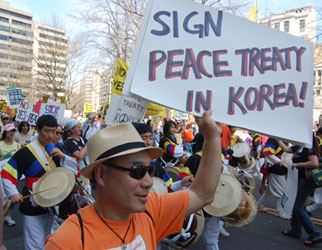 These U.S. efforts are aimed at whipping up pro-war hysteria, inside the U.S. and in the region. It directly served to secure the U.S. base in Japan, against the will of the peoples of both Korea and Japan. A firm anti-war movement in both countries is demanding that the U.S. get out and get out Now! Connected with U.S. insistence on military occupation of south Korea and Japan is its refusal to sign a peace treaty with the DPRK. It is the U.S. that has kept the peninsula in a state of war, has nuclear weapons in the region and has threatened first strike use of them against the DPRK. It is the just demand of the Koreans and all peace-loving people that the U.S. sign a peace treaty with Korea now and end all its provocations and war plans.
These U.S. efforts are aimed at whipping up pro-war hysteria, inside the U.S. and in the region. It directly served to secure the U.S. base in Japan, against the will of the peoples of both Korea and Japan. A firm anti-war movement in both countries is demanding that the U.S. get out and get out Now! Connected with U.S. insistence on military occupation of south Korea and Japan is its refusal to sign a peace treaty with the DPRK. It is the U.S. that has kept the peninsula in a state of war, has nuclear weapons in the region and has threatened first strike use of them against the DPRK. It is the just demand of the Koreans and all peace-loving people that the U.S. sign a peace treaty with Korea now and end all its provocations and war plans.
despite all the numerous actions of the U.S. to sabotage reunification, the DPRK and Koreans north, south and worldwide have continued to hold high the banner of peaceful reunification, an urgent desire of all Koreans. The continued military occupation of the south and all the U.S. sabotage has been unable to divert the Korean people from working to achieve reunification. On the contrary, the determination to be free of U.S. military occupation is increasing not only in Korea but Japan as well.
Voice of Revolution salutes the successes of the Korean people in their nation-building project, which have the full sympathy of all of humanity. The unflinching stand of the DPRK, her fight for sovereignty and for the dignity of all Koreans, represent a bulwark against U.S. ambitions in the region, its preparations for fascism and war and its ultimate aim of dominating the world.
On the occasion of the upcoming tenth anniversary of the June 15 Joint Declaration, Voice of Revolution sends its warmest revolutionary greetings to the Korean people and their leadership and wishes them every success in their historic mission to reunify their nation. By relying on their own efforts, defending their independence and defying the U.S. imperialists on the basis of their principles and convictions they are sure to achieve victory.
Voice of Revolution calls on all its supporters and readers to support the Korean people in their historic task of national reunification. As Americans have the responsibility to demand that all U.S. troops and weapons be removed from Korea now, that the U.S. disarm all its nuclear weapons and ban the policy of pre-emptive first strike, and immediately act to sign a peace treaty with the DPRK and normalize relations NOW!.
U.S. Troops Out of Korea!
Vigorously Support the Reunification of Korea!
Korea is One!
[TOP]
June 15 Declaration a Great Program for Independent Reunification
The June 15 Joint Declaration [of north and south Korea] and the October 4 declaration serve as great programs for independent reunification. They clearly indicate the path forward for the Korean nation in her efforts to achieve independent reunification, peace and prosperity. A June 11 article in Rodong Sinmun continued: The June 15 joint declaration, a just one reflecting the desire and demand of the nation for independent reunification, clarifies the fundamental principles for national reunification. National reunification should be achieved by the efforts of the Korean nation independent of foreign forces. Koreans north and the south have not yet achieved the reunification of the country, so much desired by them, even though this division has lasted more than half a century. One of the main reasons lies in the south Korean ruling forces’ treachery of persisting in the policy of sycophancy toward the U.S. and dependence on outside forces.
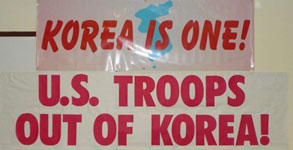 The principle of national independence is clearly reflected in the idea of “By our nation itself” enshrined in the joint declaration. “By our nation itself” is the basic spirit and central core of the June 15 Joint Declaration. The declaration injected the truth into the hearts of all Koreans with the great motto of “By our nation itself,” a popular and patriotic motto acceptable to every Korean. National reunification should be independently achieved, free from foreign forces.
The principle of national independence is clearly reflected in the idea of “By our nation itself” enshrined in the joint declaration. “By our nation itself” is the basic spirit and central core of the June 15 Joint Declaration. The declaration injected the truth into the hearts of all Koreans with the great motto of “By our nation itself,” a popular and patriotic motto acceptable to every Korean. National reunification should be independently achieved, free from foreign forces.
The declaration has fully demonstrated its vitality in practice. It is the truth taught by history and the reality that the adherence to the declaration and its implementation guarantee the existence of the Korean nation and its peace and reunification.
Denial of the Joint Declaration would lead to confrontation and collapse of inter-Korean relations. All Koreans in the north and the south and overseas should launch a more dynamic struggle to defend and implement the Joint Declaration and thus decorate this year with success in the movement for national reunification.
Implementation of Inter-Korean Declarations Called For
It is the most urgent task facing the Korean nation at present to meet all challenges of the anti-reunification forces and give a strong impetus to the trend of the era of independent reunification under the banner of the June 15 Joint Declaration.
The moves of the south Korean conservative group to block the advance of the June 15 era of reunification and provoke a war of aggression against the Democratic Peoples Republic of Korea in collusion with foreign forces reached an extremely reckless phase with the case of the warship Cheonan’s sinking.
The prevailing situation urgently requires all the Koreans at home and abroad to resolutely meet the vicious challenges of the anti-reunification forces at home and abroad with the might of the national unity and wage a dynamic movement for national reunification under the banner of the Joint Declaration.
All the fellow countrymen in the north, south and abroad should achieve positive solidarity and alliance irrespective of ideology, political view and “ism” and block and frustrate the puppet group’s anti-reunification moves.
Peace is achievable only through a bold struggle to smash the moves of the warmongers at home and abroad to escalate the confrontation and start a war.
The difficulties the Korean nation is facing in its way of the strenuous struggle for national reunification are temporary. But it is sure to triumph. No force on earth can block the dynamic advance of all the Koreans towards independent reunification, peace and prosperity under the banner of the June 15 Joint Declaration.
[TOP]
Text of North-South Joint Declaration
True to the noble will of all the fellow countrymen for the peaceful reunification of the country, Chairman Kim Jong Il of the National Defense Commission of the Democratic People’s Republic of Korea (DPRK) and President Kim Dae Jung of the Republic of Korea (ROK) had a historic meeting and summit in Pyongyang from June 13 to 15, 2000.
The heads of the North and the South, considering that the recent meeting and summit, the first of their kind in history of division, are events of weighty importance in promoting mutual understanding, developing inter-Korean relations and achieving peaceful reunification, declare as follows:
1. The North and the South agreed to solve the question of the country’s reunification independently by the concerted efforts of the Korean nation responsible for it.
2. The North and the South, recognizing that a proposal for federation of lower stage advanced by the North side and a proposal for confederation put forth by the South side for the reunification of the country have elements in common, agreed to work for the reunification in this direction in the future.
3. The North and the South agreed to settle humanitarian issues, including exchange of visiting groups of separated families and relatives and the issue of unconverted long-term prisoners, as early as possible on the occasion of August 15 this year.
4. The North and the South agreed to promote the balanced development of the national economy through economic cooperation and build mutual confidence by activating cooperation and exchanges in all fields, social, cultural, sports, public health, environmental and so on.
5. The North and the South agreed to hold dialogues between the authorities as soon as possible to implement the above-mentioned agreed points in the near future.
President Kim Dae Jung cordially invited Chairman Kim Jong Il of the DPRK National Defense Commission to visit Seoul. Chairman Kim Jong Il agreed to visit at an appropriate time in the future.
[TOP]
National Defense Commission of DPRK
Truth Behind “Story of Attack by North”
On May 25, the Democratic People's Republic of Korea (DPRK) released the following article in connection with the south Korean regime’s allegation about the north’s “torpedo attack” on the south Korean warship Cheonan:
The spokesman for the DPRK's National Defense Commission solemnly declared the principled position of our army and people on the reckless steps the Lee Myung Bak regime of traitors is going to take against the DPRK after alleging that the Cheonan was attacked by the north’s torpedo.
The spokesman also said the NDC decided to send an inspection group to south Korea to verify first hand the “evidence” advertised by the south Korean regime linking the vessel’s sinking with the DPRK.
But the regime has persistently refused to allow the inspection group’s on-the-spot verification, afraid that its allegation would be proven false.
From the very outset, we have felt no need to talk about the incident as it is an absurd ploy kicked off by the regime to hurt the DPRK.
Since the regime has refused to accept our recognized demand, however, we cannot but reveal the truth behind the incident.
1. “Story about torpedo attack by the north” is what the south Korean regime invented.
At around 9 pm on March 26, Cheonan went down, broken in two parts, from an unknown cause in the West Sea of Korea off Paekryong and Taechong islands.
On May 20, some 50 days after the tragedy, the south Korean regime made public a “report on the results of a joint investigation” alleging that it was hit by the north’s torpedo.
But its allegation is a sheer fabrication cooked up in an effort to deliberately link the case with the DPRK from the day the ship’s sinking occurred.
The allegation is illustrated by the “pieces of evidence” produced by the “joint investigation team” under the manipulation of the regime.
Let’s get down to, first of all, an “extremely small amount of powder” that it said was detected from the funnel and the broken edge of the vessel.
The “investigation team” said the detected powder was proven to be RDX, which is used in making torpedoes, concluding that the vessel was sunken by the north’s torpedo.
RDX is a white crystalline, non-aqueous high explosive that is known to be used by many countries in munitions and other industrial sectors, with south Korea being no exception.
It is unreasonable to correlate the use of such powder with the north’s torpedoes and it is also groundless to ascribe the tragedy to the torpedo.
It is hard to swallow that powder was detected on the hull of the sunken vessel and its funnel [i.e., the smokestack]. The vessel had remained under the salt water, washed over by strong currents for many days. Its survivors said there was no smell of powder when the vessel was sinking. And fishermen testified that they saw no dead fish or seaweed floated by a strong explosion on the spot. Such facts are enough to excite public doubts.
The spot has often been used as a theatre of target practices by the south Korean puppet navy and marine corps with such guns as K-9 and KH-179 howitzers.
A member of the “civilian-military joint investigation team” said that it may be possible to find a sign of powder under the water as the spot is a fixed point of the firing, but if the vessel was broken into two by an explosion 30 feet under the water, not by a direct hit, it is nonsense to allege that a sign of powder was detected from the funnel or hull of the vessel.
He also said if the allegation were true, the undersurface of the vessel should have been thickly coated with powder.
The “investigation team,” finding no words to answer to a question whether the powder detected was compared with that used by south Korea, categorically alleged it to be the north’s. Experts point out, the analysis “of an amount of powder as small as one ten billionth of a gram” is hardly conclusive.
The “evidence,” which can be invented only by those rabid with anti-north confrontation and plots, could not be used in the final investigation results for fear that it would be rejected by the public.
The same holds true for “another piece of evidence” offered by the “investigation team.”
The south Korean regime had combed the area 500 meters (1,640 feet) around the spot to find debris since the incident occurred.
After many days, however, it suddenly announced that “alloy fragments” crucial for the probe into the incident were found.
It said that the fragments were proven to be an alloy of aluminum and magnesium, both used in making a torpedo’s exterior. As evidence of “north’s torpedo attack,” they claimed they are the same as material from a practice torpedo of the north obtained by the south side seven years ago.
Admittedly, aluminum and magnesium are used in diverse fields. They were apparently used in building the submerged vessel, too.
Strangely enough, the metal fragments were confirmed to be the “north’s.”
Many doubts have also arisen as regards the afterbody of the torpedo, allegedly found out in the water under the spot of the incident prior to the announcement of the “investigation results.”
The regime, citing it as “another crucial piece of evidence,” has asserted that the after-body with five propellers, engine, control device and driving shaft left undamaged is the same in size, shape and composition with CHT-02D torpedo design in the north’s pamphlet introducing its “weapons for export.”
Does the assertion really sound reasonable?
Even the bow and stern of the vessel, as heavy as hundreds of tons, were tossed about by currents and six of its crew reported missing because their bodies have not yet been found out. Such being the case, it is unimaginable that the 1.5-meter-long (5-foot) afterbody of the torpedo remained in the same place for some 50 days and that a fishing boat pulled up the afterbody with a fish net despite scores of U.S. and south Korean warships equipped with up-to-date detection devices having failed to find it.
The south Korean regime has even offered photos in a bid to justify its assertion but they only reveal that it is a lie.
Besides, the assertion that the screw shaft and engine remained undamaged and unchanged in shape is also a laughing shock. Even U.S. and British members of the international investigation team, which had blindly backed the south Korean regime in its “investigation,” were perplexed at the exhibit in a glass box.
It lacks logic to include detailed torpedo designs considered top-secret in pamphlets available in other countries.
It is the view of experts that the condition of a torpedo severely heated by self-explosion cannot be the same state of corrosion as the edges of a vessel broken by a non-contact explosion.
“No. 1” written in the rear part of the screw in the “writing style of the north” is what the south Korean regime has produced as the “clearest piece of evidence.”
It is a matter of common sense to leave no clue in a stealthy attack.
Even south Korean experts, with doubts that the north left such a clue, are of the view that the number of the screw that allegedly remained intact under the water for many days was not carved by a machine but handwritten with a blue felt-tip pen apparently some time ago.
They also say the north’s style of marking number in military equipment is quite different from that produced by the south side as “evidence.”
The “evidence” is so poor that south Koreans ridicule it, saying, “The north is very kind to write the letters in the part unapt to rust,” “Blue bus No. 1 on the street is what infiltrated the south from the north,” “The letters are similar with those of my 8-year-old nephew. Then is my nephew also a spy?” and “Anyone who votes for No. 1 (the number of the Grand National Party in elections to local self-governing bodies) is a traitor.”
The same is true for the north’s submarine infiltration route offered by the south Korean regime as “another piece of evidence.”
The “civilian-military joint investigation team” alleged that the submarine left its base at night three days before the occurrence of the incident, approached the Cheonan after making a channel detour in the open sea, attacked the vessel and went back through the same course.
Encountering the demand for a detailed explanation, however, it said it is difficult for any countries to track a submarine’s underwater movement so that the infiltration and return course of the north’s submarine could not be confirmed.
Asked how a small submarine [normally equipped with a] 300 kg torpedo could hit the 1,400 ton vessel with a 1.7 ton torpedo in the West Sea where the underwater topography is so complicated and objects can hardly be recognized even within ten meters, the “investigation team” answered that it might be possible if the submarine underwent training beforehand in similar water.
The spot of the incident is in the troubled water of the north and the south of Korea where the south side has allegedly maintained an alert posture with many detection and monitoring systems.
Furthermore, when the vessel met its mishap, the “Foal Eagle” joint military maneuvers were at their height with flotillas of various naval vessels and means of underwater and aerial reconnaissance mobilized in anti-warship, anti-submarine, anti-air, sea lane blocking and other operations.
Nevertheless, the investigation team,” just visualizing the infiltration course of the “north’s submarine,” invented the “channel course.”
Commenting on the “investigation results,” south Korean press have said that they should have been worked out in an exact and certain way so that they could never be faulted by others but they were made with imagination in such a way as incriminating the north without grounds, only to amplify doubts. They have also said that it is not only Cheonan but public trust in the Lee Myung Bak regime that was sunken, that the incident has aroused more and more doubts and deepened mistrust and that if someone [involved in the investigation] makes public a declaration of conscience in the future, the regime will surely face a miserable fate for its fabrication.
It is only too natural that progressive media of south Korea decided to form a committee to verify the “investigation results” made public by the south Korean regime.
As the facts show, the “crucial pieces of evidence” produced by the south Korean regime, a master of fabrication and concoction, are nothing but fabrications from A to Z, inviting serious doubts.
[TOP]
South Koreans Oppose Confrontation and
Demand Probe into Cheonan Sinking
On May 26, 91 civic, public and religious organizations and opposition parties held an emergency meeting on the situation for peace of the Korean Peninsula at the Paekbom Memorial Hall in Seoul May 26. Among them were the Democratic Party, the Democratic Labor Party, the South Headquarters of the Pan-national Alliance for Korea’s Reunification, the Citizens’ Solidarity for Democratic Society, the Women’s Solidarity, the Catholic Priests’ Council for Justice and the Association of Buddhist Priests for Realizing Buddhism. The organizations declared that they would jointly react to the puppet group of traitors’ reckless acts, which are aggravating the situation. They adopted a declaration on the situation demanding that the authorities immediately stop the anti-DPRK provocative rackets and lift measures for a military confrontation, which may lead to a war.
Eighty-nine former south Korean lawmakers also issued a statement on May 26 urging the puppet authorities to immediately stop misusing the sinking of the Cheonan for their narrow political aims.
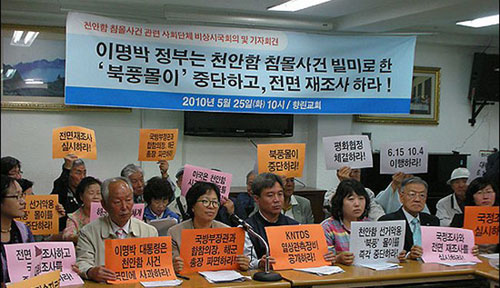
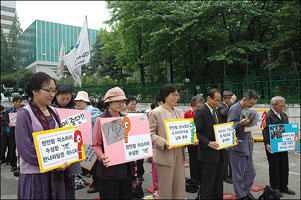
![]()
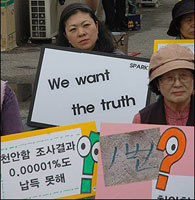
Seoul, Korea, May 25, 2010: Public meeting (top) and a demonstration at the offices of the
Department of Civil Defence to demand a reinvestigation of the sinking of the Cheonan. (SPARK)
On May 25, members of 37 civic and public organizations in south Korea, including the People for Achieving Peace and Reunification and the Solidarity for Implementing the South-North Joint Declaration, called a press conference in Seoul, demanding the disclosure of information about the sinking of the warship Cheonan and an overall reinvestigation into the incident.
They held that the U.S.-south Korean investigation into the case, supervised by the military authorities, was conducted in such a prejudiced manner to draw the conclusion that the warship was sunk by “a torpedo of the north,” while the key information was withheld from the public.
Religious organizations on May 24 sent a letter of protest to the U.S. embassy in Seoul urging the U.S. to release the real information behind the sinking of the Cheonan and properly probe the truth behind the case.
[TOP]
Beijing Suspects False Flag Attack on South Korean Corvette
Waye Madsen Report’s(WMR) intelligence sources in Asia suspect that the March attack on the South Korean Navy anti-submarine warfare (ASW) corvette, the Cheonan, was a false flag attack designed to appear as coming from North Korea.
One of the main purposes for increasing tensions on the Korean peninsula was to apply pressure on Japanese Prime Minister Yukio Hatoyama to reverse course on moving the U.S. Marine Corps base off Okinawa. Hatoyama has admitted that the tensions over the sinking of the Cheonan played a large part in his decision to allow the U.S. Marines to remain on Okinawa. Hatoyama’s decision has resulted in a split in the ruling center-left coalition government, a development welcome in Washington, with Mizuho Fukushima, the Social Democratic Party leader threatening to bolt the coalition over the Okinawa reversal.
The Cheonan was sunk near Baengnyeong Island, a westernmost spot that is far from the South Korean coast, but opposite the North Korean coast. The island is heavily militarized and within artillery fire range of North Korean coastal defenses, which lie across a narrow channel.
The Cheonan, an ASW corvette, was decked out with state-of-the-art sonar, plus it was operating in waters with extensive hydrophone sonar arrays and acoustic underwater sensors. There is no South Korean sonar or audio evidence of a torpedo, submarine or mini-sub in the area. Since there is next to no shipping in the channel, the sea was silent at the time of the sinking.
However, Baengnyeong Island hosts a joint U.S.-South Korea military intelligence base and the US Navy SEALS operate out of the base. In addition, four U.S. Navy ships were in the area, part of the joint U.S-South Korean Exercise Foal Eagle, during the sinking of the Cheonan. An investigation of the suspect torpedo’s metallic and chemical fingerprints show it to be of German manufacture. There are suspicions that the U.S. Navy SEALS maintains a sampling of European torpedoes for sake of plausible deniability for false flag attacks. Also, Berlin does not sell torpedoes to north Korea, however, Germany does maintain a close joint submarine and submarine weapons development program with Israel.
The presence of the USNS Salvor, one of the participants in Foal Eagle, so close to Baengnyeong Island during the sinking of the South Korean corvette also raises questions.
The Salvor, a civilian Navy salvage ship, which participated in mine laying activities for the Thai Marines in the Gulf of Thailand in 2006, was present near the time of the blast with a complement of 12 deep sea divers.
Beijing, satisfied with North Korea’s Kim Jong Il’s claim of innocence after a hurried train trip from Pyongyang to Beijing, suspects the U.S. Navy’s role in the Cheonan’s sinking, with particular suspicion on the role of the Salvor. The suspicions are as follows:
1. The Salvor engaged in a seabed mine-installation operation, in other words, attaching horizontally fired anti-submarine mines on the sea floor in the channel.
2. The Salvor was doing routine inspection and maintenance on seabed mines, and put them into an electronic active mode (hair trigger release) as part of the inspection program.
3. A SEALS diver attached a magnetic mine to the Cheonan, as part of a covert program aimed at influencing public opinion in South Korea, Japan and China.
The Korean peninsula tensions have conveniently overshadowed all other agenda items on Secretary of State Hillary Clinton’s visits to Beijing and Seoul.
Wayne Madsen is a Washington, DC-based investigative journalist and nationally-distributed columnist. He is the editor and publisher of the Wayne Madsen Report.
[TOP]
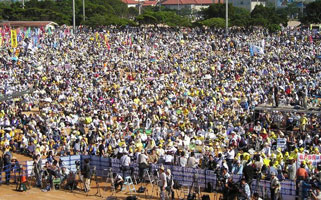 The United States is on the verge of permanently damaging its alliance with Japan in a dispute over a military base in Okinawa. This island prefecture hosts three-quarters of all U.S. military facilities in Japan. Washington wants to build one more base there, in an ecologically sensitive area. The Okinawans vehemently oppose it, and tens of thousands gathered last month to protest the base. Tokyo is caught in the middle, and it looks as if Japan’s prime minister has just caved in to the U.S. demands.
The United States is on the verge of permanently damaging its alliance with Japan in a dispute over a military base in Okinawa. This island prefecture hosts three-quarters of all U.S. military facilities in Japan. Washington wants to build one more base there, in an ecologically sensitive area. The Okinawans vehemently oppose it, and tens of thousands gathered last month to protest the base. Tokyo is caught in the middle, and it looks as if Japan’s prime minister has just caved in to the U.S. demands.
In the globe-girdling array of overseas military bases that the United States has acquired since World War II — more than 700 in 130 countries — few have a sadder history than those we planted in Okinawa.
In 1945, Japan was of course a defeated enemy and therefore given no say in where and how these bases would be distributed. On the main islands of Japan, we simply took over their military bases. But Okinawa was an independent kingdom until Japan annexed it in 1879, and the Japanese continue to regard it somewhat as the U.S. does Puerto Rico. The island was devastated in the last major battle in the Pacific, and the U.S. simply bulldozed the land it wanted, expropriated villagers or forcibly relocated them to Bolivia.
From 1950 to 1953, the American bases in Okinawa were used to fight the Korean War, and from the 1960s until 1973, they were used during the Vietnam War. Not only did they serve as supply depots and airfields, but the bases were where soldiers went for rest and recreation, creating a subculture of bars, prostitutes and racism. Around several bases fights between black and white American soldiers were so frequent and deadly that separate areas were developed to cater to the two groups.
The U.S. occupation of Japan ended with the peace treaty of 1952, but Okinawa remained a U.S. military colony until 1972. For 20 years, Okinawans were essentially stateless people, not entitled to either Japanese or U.S. passports or civil rights. Even after Japan regained sovereignty over Okinawa, the American military retained control over what occurs on its numerous bases and over Okinawan airspace.
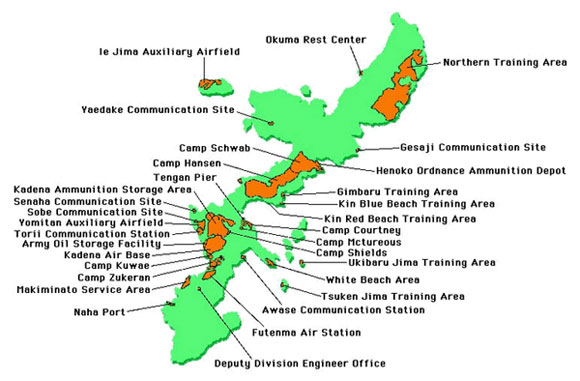
Since 1972, the Japanese government and the American military have colluded in denying Okinawans much say over their future, but this has been slowly changing. In 1995, for example, there were huge demonstrations against the bases after two Marines and a sailor were charged with abducting and raping a 12-year-old girl. In 1996, the U.S. agreed that it would be willing to give back Futenma, which is entirely surrounded by the town of Ginowan, but only if the Japanese would build another base to replace it elsewhere on the island.
So was born the Nago option in 1996 (not formalized until 2006, in a U.S.-Japan agreement). Nago is a small fishing village in the northeastern part of Okinawa’s main island and the site of a coral reef that is home to the dugong, an endangered marine mammal similar to Florida’s manatee. In order to build a large U.S. Marine base there, a runway would have to be constructed on either pilings or landfill, killing the coral reef. Environmentalists have been protesting ever since, and in early 2010, Nago elected a mayor who ran on a platform of resisting any American base in his town.
Yukio Hatoyama, the Japanese prime minister who came to power in 2009, won partly on a platform that he would ask the United States to relinquish the Futenma Marine Corps Air Station and move its Marines entirely off the island. But on [May 4], he visited Okinawa, bowed deeply and essentially asked its residents to suck it up. [On June 2, Prime Minister Hatoyama resigned over his broken campaign promise to close the Futenma air base.]
I find Hatoyama’s behavior craven and despicable, but I deplore even more the U.S. government’s arrogance in forcing the Japanese to this deeply humiliating impasse. The U.S. has become obsessed with maintaining our empire of military bases, which we cannot afford and which an increasing number of so-called host countries no longer want. I would strongly suggest that the United States climb off its high horse, move the Futenma Marines back to a base in the United States (such as Camp Pendleton, near where I live) and thank the Okinawans for their 65 years of forbearance.
Chalmers Johnson is the author of several books, including “Blowback.” This item was published in the Los Angeles Times.
[TOP]
U.S. Creates Atmosphere of International Pressure
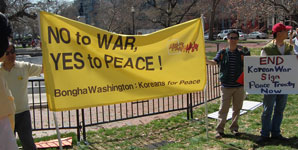 The U.S. Secretary of State and its chief imperial emissary Hillary Clinton issued the outrageous demand on May 26 that the international community must respond to the “unacceptable provocation” by the Democratic People’s Republic of Korea (DPRK) referring to the claim of the U.S. and south Korean-led “investigation” into the sinking of the Cheonan. “The international community has a responsibility and a duty to respond,” she told a news conference in Seoul. Turning reality on its head she claimed there was “overwhelming” evidence that the DPRK was to blame. She added: “We call on North Korea to halt its provocations and its policy of threats and belligerence towards its neighbors The United States is also reviewing additional options and authorities to hold North Korea and its leaders accountable.”
The U.S. Secretary of State and its chief imperial emissary Hillary Clinton issued the outrageous demand on May 26 that the international community must respond to the “unacceptable provocation” by the Democratic People’s Republic of Korea (DPRK) referring to the claim of the U.S. and south Korean-led “investigation” into the sinking of the Cheonan. “The international community has a responsibility and a duty to respond,” she told a news conference in Seoul. Turning reality on its head she claimed there was “overwhelming” evidence that the DPRK was to blame. She added: “We call on North Korea to halt its provocations and its policy of threats and belligerence towards its neighbors The United States is also reviewing additional options and authorities to hold North Korea and its leaders accountable.”
Right on cue, south Korean Foreign Minister Yu Myung-Hwan obediently chimed in that he and Clinton had agreed that the DPRK should take responsibility for the sinking of the Cheonan. He also recommended letting the UN Security Council handle the matter. Rivaling Clinton with her shameless lies, the minister stated, “When we are taking this to the Security Council, the most important thing is the facts. I believe we should let the facts lead everything.”
A spokesman for the DPRK Foreign Ministry on Friday released the following statement in connection with the fact that the United States is becoming all the more reckless in its moves to create an atmosphere of international pressure on the DPRK by referring the Cheonan case to the UN Security Council (UNSC):
“Recently the U.S. Secretary of State let loose a spate of sheer lies to brand the DPRK as the chief culprit in the warship sinking during her junkets to Japan, China and south Korea.
“But scrutiny into who benefits from the ‘story about a torpedo attack by north Korea’ and what will be gained from it makes it clear that the case was orchestrated by the U.S. and the south Korean authorities. Firstly, the Obama administration is using the recent case to orchestrate a farce to make it appear ‘strong’ with the mid-term Congressional elections slated for this November. In the first year of its administration it has gained the reputation of being externally weak. Secondly, the U.S. hyped the ‘threat from north Korea’ to finally make the ruling Democratic Party of Japan, which had been keen to drive the U.S. forces out of Okinawa, yield to it. This is the reason why the ‘results of investigation’ were announced in May. Thirdly, the U.S. has to justify its policy of ‘strategic patience’ designed to degrade the environment for international investment in the DPRK and steadily suffocate its economy. Fourthly, it became possible for the U.S. to put China into an awkward position and to keep its hold on Japan and south Korea as its servants.
“The truth remains unchanged though the U.S. sticks to its own opinion. The U.S. is blustering that it would refer the case to the UNSC, but the UNSC is the very forum which has already been besmirched due to Powell’s lies about Iraq in February 2003. The U.S., branding the case as a ‘breach of the Armistice Agreement’ (AA), instigated the south Korean authorities to spread the assertion that the case should be discussed at the ‘Military Armistice Commission’ (MAC). This is also a self-contradiction. As far as the AA is concerned, it was reduced to a dead document long ago due to the U.S. The MAC has been defunct since the U.S. unilaterally recalled the senior member of the ‘UN Forces’ side and replaced him with a ‘general’ of the south Korean puppet army, whhich is not a signatory to the AA. As the MAC exists only in name, the U.S. government made a conclusion that the case is a ‘violation of the AA’ before the ‘UN Forces’ side of the MAC announced that it would make an investigation into the violation. [...]
“No sooner had the U.S. and the south Korean authorities announced the ‘results of the investigation’ than they threatened to slap additional sanctions and take counter-actions regardless of whether the world understands those results or not. Herein lies an ulterior aim and this patently proves that they are acting according to a script already worked out.
“The U.S. is seriously mistaken if it thinks it can occupy the Korean Peninsula just as it did Iraq with sheer lies. If the UNSC is again taken in by U.S. lies and tables the ‘results of the investigation’ into the Cheonan warship and discusses them, then this will mean that the UNSC is being misused to encroach upon the dignity of the Korean people and the sovereignty of the DPRK. In the case that the DPRK takes toughest self-defensive counter-measures as already declared, the U.S. and its servants will be wholly to blame for their consequences.”
[TOP]
The Anti-War Movement of the Peoples of East Asia Cannot Be Stopped
Using the fabricated pretext of DPRK involvement in the sinking of a south Korean warship, the U.S. and Japan are renewing their military base agreement in direct opposition to a growing anti-war movement demanding the U.S. military “Get Out of East Asia!”
A U.S. invented pretext of the sinking of a Republic of Korea warship by the Democratic People’s Republic of Korea has become a cause célèbre to prolong the U.S. Empire’s military occupation of Okinawa, Japan. In a U.S./Japan joint statement issued May 28, Japanese Prime Minister Hatoyama officially reversed his pledge to begin the removal of U.S. military bases from Okinawa.
During the leaders’ debate of selected political parties during last year’s national election campaign, Hatoyama declared solemnly that he “would stake his life on being able to relocate [the U.S. military base] Futenma’s functions outside the prefecture (Okinawa).” Even since becoming the Party in Power, Prime Minister Hatoyama has repeatedly declared that the U.S. military base must be moved out of the prefecture “at the very least,” and was supposedly negotiating the details of a U.S. withdrawal.
These declarations and promises were in recognition of very real changes in East Asia, and the desire of the peoples of the region to remove a U.S. military presence that constantly threatens war and is the main source of instability. The economic development and confidence of both China and the Democratic People’s Republic of Korea and the direct experience with the goodwill generated by the “sunshine policies” towards Korean reunification of the previous two administrations of the Republic of Korea form a basis for new arrangements. Many in East Asia have come to realize that new anti-war arrangements of reconciliation and peaceful development can only take place through active opposition to U.S. interference in their affairs and if U.S. military bases and its nuclear-armed naval armada are removed from East Asia.
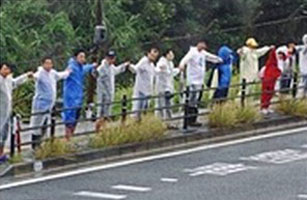
![]()
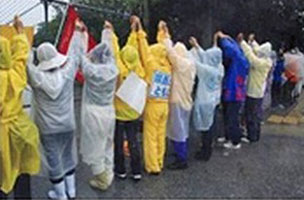
May 16, 2010: Photos taken by Okinawan scholar Yoshio Shimoji show the human chain surrounding U.S. Futenma military facility to demand an end to U.S. military facilities on the island of Okinawa. In an item entitled "The Futenma Base and the U.S.-Japan Controversy: an Okinawan perspective," published in Japan Focus, Shimoji writes that that Japan's independence was "achieved at the cost of Okinawa, which was kept under harsh military administration until the reversion of its administrative rights to Japan in 1972. But even after reversion, the U. S. bases in Okinawa remained intact. Today, the negative side of the Japan-U.S. Mutual Security Treaty appears most conspicuously in Okinawa, where 75 percent of U.S. bases and facilities in Japan are concentrated. Although those bases and facilities (totaling 85 in number, and 31,000 ha in area) are formally offered to U.S. Forces under the Security Treaty, they are in essence spoils which U.S. forces won in war."
New arrangements are never easy to bring into being and the U.S. Empire has its own experience in undermining and sabotaging the people’s movement for independence and peace. However, the direct experience of the people with each successive U.S. fabricated pretext for war and occupation has developed their political acumen. This direct experience has steeled the anti-war mass movements in Japan and the Republic of Korea against becoming diverted and undermined. The people are determined to end U.S. military occupations of their countries and to persist in their struggle in spite of U.S. imperialism’s constant lies and threats against the peace.
Within this context of a growing movement for an anti-war government, Prime Minister Hatoyama could not even force his coalition government and Cabinet to unite and agree on extending the U.S. military occupation of Okinawa. Japan’s Social Democratic Party (SDP) has decided to leave the ruling coalition after deciding to oppose the Prime Minister Yukio Hatoyama’s conciliation with the U.S. and his breaking of a campaign promise to relocate the U.S. Futenma military base on the island of Okinawa. Chair of the SDP Mizuho Fukushima informed reporters about the decision on Sunday after meeting with party executives.
Fukushima, who is calling for the immediate relocation of the base, was earlier expelled from her cabinet post as Minister of Consumer Affairs and Food Safety, Social Affairs, and Gender Equality for refusing to accept the government’s betrayal. Fukushima said of her firing, “Dismissing me means dismissing Okinawa. Dismissing me means betraying the Japanese people.”
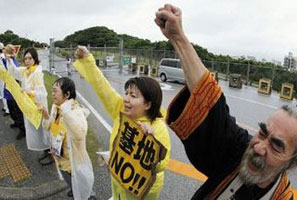 A May 28 item from Press TV noted “The issue has become the biggest challenge to Hatoyama’s government since it came to power. The premier’s failure to appease the islanders has dramatically reduced his public approval rating. [...] The SDP’s defection is a tough blow to Hatoyama’s party. The Democrats need the help of other parties to win a majority in the Upper House elections [in July].”
A May 28 item from Press TV noted “The issue has become the biggest challenge to Hatoyama’s government since it came to power. The premier’s failure to appease the islanders has dramatically reduced his public approval rating. [...] The SDP’s defection is a tough blow to Hatoyama’s party. The Democrats need the help of other parties to win a majority in the Upper House elections [in July].”
The public split in Hatoyama’s coalition government and Cabinet and the determination of the anti-war movement to block the new U.S./Japan war alliance have occurred despite the huge propaganda campaign to convince people that the DPRK wants war and that U.S. imperialism regardless of all evidence to the contrary is somehow a factor for peace.
Even the official details of the Cheonan warship’s sinking are publicly disputed, discredited and dismissed. People are demanding to know why the DPRK would want to do such a thing when it had nothing to gain, and how a submarine from such a small country could somehow manage secretly to torpedo a south Korean warship and escape undetected in shallow waters during a massive joint U.S./ROK naval military exercise involving the most sophisticated warships in the U.S. armada.
Grasping at straws, Hatoyama defended the May 28 joint statement bringing up the U.S. fabricated pretext of the sinking of a ROK warship. He said, “East Asia remains tense, including the [ship] sinking.” With those words the people are supposed to assume that the tension arises not from the continued U.S. military occupation of both Japan and Korea and its stated aim of “regime change” in the DPRK but from the DPRK itself, which even by the admission of Japan’s ruling elite does not threaten Japan let alone the United States but is certainly determined and capable of defending itself if attacked.
During a weekend meeting between the heads of state of China, Japan and south Korea, Hatoyama also stated that Japan would support the ROK if it transferred the matter to the UN Security Council. (Hatoyama was forced to resign June 2, humiliated by submitting to the U.S.)
The world has changed and it will not take years to expose the latest U.S. “Gulf of Tonkin incident” as a complete lie and pretext to sway public opinion for yet another U.S. brutal war, this time not against the people of Vietnam but once more against the people of Korea. Already the Internet is full of investigative journalists and independent experts exposing the sinking of the Korean warship as a deliberate plot to sabotage the anti-war movement of the peoples of East Asia that is demanding the removal of U.S. military bases and naval armada from the region, and the movement of the people of Korea for the reunification of their homeland by themselves without interference from the U.S. Empire and occupied Japan. People are coming together within a determined movement to force the U.S. military out of East Asia.
(TML Daily)
